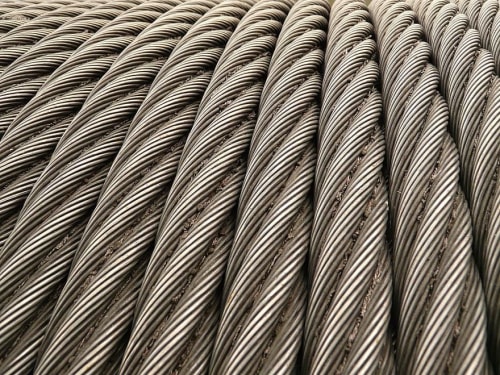
Ropes and wire strands. Definition, history, manufacturing and applications
Ropes and wire strands are metallic components used to carry and move objects and loads and to convey, lift, tension and hold elements in different applications, from elevators to suspension bridges. Ropes and strands can also be used to transmit force and mechanical power.
Wire rope properties include a high load-carrying capacity combined with flexibility and elasticity, as well as high durability and wear resistance and favorable permanent bending cycle properties. Steel wire ropes ensure a reliable function and long useful life at temperatures between -40° C and +250° C. The selection of steel wire ropes for end-use applications depends upon the load bearing capacity as well the lifespan. As the number of wires increases, the strength of the rope and its flexibility will also increase.
Depending on the area of application, also ropes made of certain non-ferrous metals and other materials such as synthetic fibers are used. Furthermore, combinations of different materials, metal wires with natural or synthetic fibers are possible. For certain applications, ropes are sheathed with plastic coatings.
Storia
At the beginning of the 19th century, hemp ropes and chains made of wrought iron were used as lifting means in the mining industry.
Hemp ropes, however, were expensive and could only be applied in dry pits. The iron chains, on the other hand, were highly stressed by the continuous winch up and down processes and failed totally when the proverbially weakest link broke – very often with catastrophic consequences. Therefore, Wilhelm August Julius Albert, an official of the German Board of Mines and adviser for the mining, was looking for a replacement for the conveyor chains.
Albrecht, who also became the founder of wire rope research, developed a steel wire rope which consisted of three strands. Each strand was built up by four wires, each 3.5 mm in diameter. The wire rope had a diameter of approximately 18 mm.
The Albert Rope had six times the load capacity of a hemp rope of the same diameter and four times the load capacity of a chain eight times as heavy. The wire rope was successfully tested on July 23, 1834 in a 484 m mine shaft at Clausthal, Germany [Roland Verreet: „A short history of steel wire ropes“].
Rope making
In the early days, steel wire ropes were made by hand on rope walks where a number of wires were laid out. Read more >>
Wire rope groups and applications
Wire ropes are used in many technical areas. According to the main uses and the acting forces, wire ropes can be divided into four main groups: wire rope slings, track wire ropes, running wire ropes, and stationary or structural wire ropes.
Wire rope slings are used to harness goods. These slings are stressed by the tensile forces and by bending stresses when they are bent over the edges of the goods.
Track wire ropes are full-locked ropes with a plastic coating which act as rails for the rollers of cabins or other loads in aerial ropeways. While track wire ropes carry the loads, haulage (or traction) ropes pull them. These ropes are used dynamically and thus belong to the group of running wire ropes. As they are running above sheaves, drums or traction sheaves, they are mainly stressed by bending and secondly by tension. Further well-known application examples are elevator ropes which lift and lower elevators and haulage ropes used in lifting and conveying systems such as cranes.
Thin steel wire ropes (also called “cables”) are often used to transmit force in mechanisms and initiate switching and safety functions in technical components. One example are the pull ropes used under the name “Bowden cables” which are applied on two-wheelers for switching or braking processes. Such ropes are also used in airplanes, where they connect the cockpit levers and pedals with the movable parts of the wings and other components. Furthermore, the function of sun protection awnings and photocopiers is based on fine wire ropes. Wire ropes are also used as saw strands, for example in medical technology, or as diamond wire ropes in quarries. Finally, conveyor belts, V-belts and the tires of vehicles are reinforced by inserted wire ropes.
Stationary or structural wire ropes are anchored at two fixed points and have to carry static and fluctuating tensile forces. Such ropes, mostly full-locked, are used to support structures such as suspension bridges or stadium roofs.
Also port facilities, oil rigs and construction sites are places where huge quantities of wire ropes are being used.
Wire rope inspection
A flaw in the wires of a steel wire rope is by far less dangerous than a flaw in a chain link, as the other wires take up the load.
Friction between the individual wires and strands of a steel wire rope helps to compensate for minor failures in the short run but causes wear over the life of the rope. Therefore, wire ropes must be inspected at regular intervals and at the latest be replaced when their discarding time is reached.
Literature
Klaus Feyrer: Wire Ropes. Tension, Endurance, Reliability.
Berlin, Heidelberg 2015 (Second Edition).
ISBN 978-3-662-49581-0
ISBN 978-3-642-54996-0 (eBook)
George A. Costello: Theory of Wire Rope. New York 1997.
ISBN 978-0-387-98202-1 (hardcover)
ISBN 978-1-4612-7361-5-1 (softcover)
ISBN 978-1-4612-1970-5 (eBook)
Roland Verreet: „A short history of steel wire ropes“
Dipl.-Ing. Roland Verreet: A Short History of Wire Rope.
www.seile.com
www.ropetechnology.com/bro_engl/casar_history.pdf
Wire Rope Hand Book. Usha Martin Limited.
http://www.ushamartin.com/wp-content/uploads/2014/04/Wire-Rope-Handbook.pdf
Wire Rope User’s Handbook. Union. A WireCoWorldGroup Brand.
https://www.unionrope.com/Portals/0/Documents/Technical/Wire-Rope-Basics/wire-rope-handbook.pdf
The information has been compiled by Dipl.-Ing. Konrad Dengler, technical journalist and translator specialised in industrial topics.
